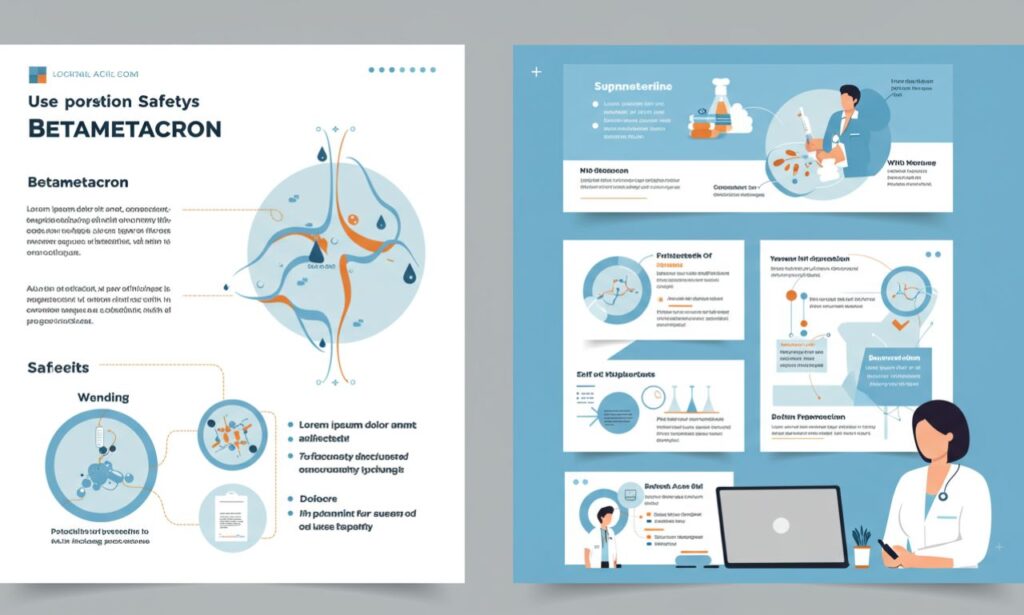Betametacron refers to betamethasone formulations—corticosteroids prescribed in topical or injectable form to reduce inflammation, itching, swelling, and allergic responses. It includes potent variants like betamethasone dipropionate and valerate, available as cream, gel, lotion, ointment, spray, foam, or injection
As a glucocorticoid, betametacron works by suppressing immune responses and inflammatory pathways. Its potent properties make it a go‑to for many dermatologic and systemic inflammatory conditions
Forms of betametacron
Betametacron appears in several types:
-
Topical forms: cream, gel, ointment, lotion, spray, foam – used for skin disorders like eczema, psoriasis, dermatitis, itching, redness, scaling
-
Injectable forms: betamethasone sodium phosphate and/or acetate – used for systemic inflammatory diseases such as arthritis, lupus, asthma exacerbations, adrenal insufficiency, multiple sclerosis, Crohn’s disease, and to accelerate fetal lung development in preterm labor
betametacron Uses and Indications
Skin Conditions
As a topical, betametacron treats inflammatory skin conditions—relieving itchiness, redness, and swelling in eczema, psoriasis (especially plaque type), and dermatitis. Spray forms are specifically approved for mild to moderate plaque psoriasis in adults .
Systemic Inflammation
The injectable betametacron is used to manage allergic reactions, rheumatologic disorders, Crohn’s disease, severe asthma, and endocrine imbalances. It’s also used to mature fetal lungs in preterm labor
How betametacron Works
Betametacron acts by binding to glucocorticoid receptors, inhibiting inflammatory mediator release, and suppressing immune cell activity. In skin use, it slows down skin cell proliferation and reduces redness and scaling Dosage and Administration for betametacron
-
Topical use: apply a thin layer once or twice daily as directed. Spray may be used twice daily for up to four weeks in psoriasis. Creams or lotions are often used once or twice a day, foam formulations as needed on the scalp Injectable use: dosage depends on condition severity, patient weight, and disease. Administered by healthcare professionals, often as single or repeated doses depending on clinical response
betametacron Side Effects
Common and Mild Effects
Topical betametacron may cause temporary burning or stinging on application, mild skin thinning, pigment changes, stretch marks (especially if used long term or on large areas). Systemic use may cause elevated blood sugar, increased appetite, weight gain, mood swings, insomnia, and fluid retention
Serious and Long‑Term Risks
Prolonged or over‑use can lead to adrenal suppression, hypertension, glaucoma, cataracts, osteoporosis, stunted growth in children, and increased infection risk . Allergic reactions are rare but severe reactions like anaphylaxis may occur
Precautions When Using betametacron
Consult your healthcare provider before starting betametacron. Important considerations include:
-
Not to use on infected skin areas unless treated appropriately.
-
Avoid use on sensitive regions (face, groin, armpits) unless directed and short term.
-
In children and adolescents, prolonged use can slow growth; regular monitoring is recommended
-
If using injectable betametacron, medical monitoring is required to manage potential systemic complications like blood pressure elevation, electrolyte imbalance, immune suppression
Interactions and Contraindications
-
Interacts with vaccines (especially live ones), anticoagulants (e.g. warfarin), aspirin, mifepristone, and other immunosuppressants
-
Avoid alcohol and tobacco, which can worsen side effects.
-
Disclose medical history such as diabetes, liver or kidney disease, glaucoma, hypertension, infections, Cushing’s syndrome before use
Monitoring and When to Stop
Topical effect should improve within 2 weeks. If symptoms persist or worsen, consult your doctor. For systemic use, regular follow-up is essential to monitor side effects, lab values, and dose adjustments. Do not stop injectable betametacron abruptly; taper under medical supervision to avoid adrenal crisis
Advantages of Using betametacron Properly
-
Rapid relief from inflammation and itching.
-
Versatile: topical, spray, foam, injection depending on indication.
-
Widely available and generic, making it accessible.
-
Long track record and included in WHO essential medicines list
Limitations and Warnings
-
Potential for serious side effects with misuse, especially long‑term or topical occlusion.
-
Should not be used indiscriminately in children or pregnant/breastfeeding women without caution.
-
Risk of systemic absorption even from topical use on large or sensitive areas.
-
Requires medical supervision when used systemically or chronically.
Best Practices for Safe betametacron Use
-
Use the lowest effective potency and smallest area needed, for the shortest duration.
-
Follow prescription instructions: thin layer, once or twice daily, no occlusion unless directed.
-
Avoid facial use or sensitive zones unless advised.
-
Watch for side effects like skin changes, mood swings, increased thirst or urination.
-
Don’t abruptly stop systemic use; taper gradually under supervision.
-
Inform healthcare provider about all other medications, vaccines, and health conditions.
Conclusion
Betametacron—betamethasone in various formulations—is a powerful anti‑inflammatory medication employed topically and systemically to manage a wide range of conditions. When used correctly, it provides effective relief from skin and systemic inflammation. However, its potency requires precision: appropriate strengths, minimal duration, cautious use in vulnerable populations, and regular follow‑up. Awareness of possible side effects, drug interactions, and how to taper systemic use safely ensures optimal benefit while minimizing risks.







